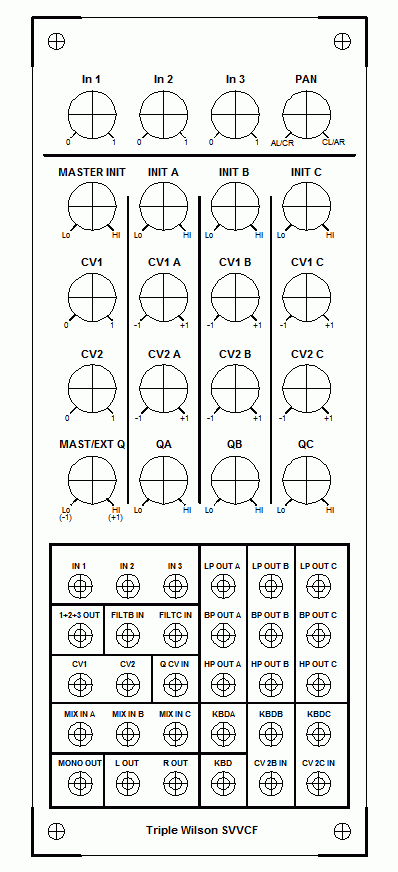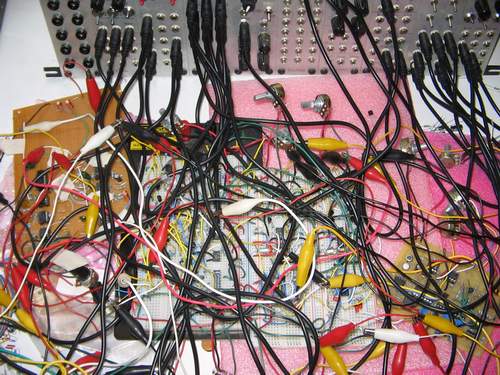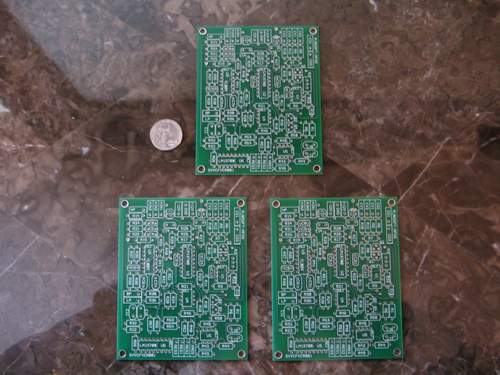Triple Wilson SVVCF
A Module Based on Ray Wilson's State Variable Voltage Controlled Filter
Not that I have anything against Vactrols (far from it), but for my resonator, I wanted to try something a bit more versatile - something that had more of the classic synth's control over resonance and tracking capability, as well as providing other functions and effects. A thread came around on the Electro-Music forum concerning resonators, and again I started wondering about it.
Since I was knee deep in the Klee Sequencer, and I'd been sketching two months straight on another far-fetched project, I figured now was as good a time as any to try it out =0).
I'd already scoped Ray Wilson's SVF as the likely candidate to base the project on, mainly because you just can't go wrong using Ray's stuff, and also, his SVF had voltage control of resonance, which was a vital part of the plan - there had to be an efficient means to simultaneously control the resonance of all three filters.
So, one snowy morning, armed with a schematic from Music From Outer Space, I descended into the laboratory to see how it all worked out. BTW- for the 1% of people on this planet who are not aware of Music From Outer Space, Ray Wilson's end-all-be-all Synth DIY site, it can be found here:
And the particular design I'm using can be found here:
Breadboarding the Design
I began breadboarding the filter, and, when I was done, hooked it up to a VCO and gave it a listen. I was immediately rewarded with the sound of an outstanding filter - even if one is not putting three of these babies in one module, everyone should have at least one....no.....three....no....two. Well, at the very least one. In fact, within 30 seconds of playing with the filter, I knew I had to follow my 'At first do no harm' rule when creating this module, which is to say, while it shall serve its purpose as a triple resonant filter, the original functionality and sound of the filter must be preserved as well. In the case of this module, it is - times three.
Now that I knew I had a good quality, juicy filter to base the module on, I then began breadboarding two more the next morning (after spending the first day happily playing with the first filter).
Once the other two filters were breadboarded and working, I mixed the outputs in my mixer module and began exploring the feasibility of them working in concert to provide a triple resonant effect like the beloved PS3100 Resonator.
First Sound Samples
Again, I was not disappointed - here is a collage of sounds from that first expedition. All of the sounds were created on my modular, using two of my trusty Schmitz VCO3s, a Wilson EG, the noise output of my DSC2000, and a couple of Wilson LFOs. Add to that a bit of my Buchla 266 based S&H, a delay on a couple of tracks, and, at the very end, about five to ten seconds of Dim C.
A little while later, I recorded this sample as well. It's a multitracked sample using my modular with the SVVCF as the only filter, heavily processed through my Lexicon delay
Now it was time to determine the feature set.
Choosing the Feature Set
First of all, if I had infinite panel space, I could *really* trick this module out. But, because I indeed do not have an amount of panel space that even begins to approach infinity, I had to temper what could be done with what should be done.
The original objective of the module was to create a filter with a triple resonant response. I'll back-track a bit here and go over exactly what a triple resonant filter is, using the PS3100 Resonator as an example:
The PS3100 resonator is made up of three independent bandpass filters. The filters are arranged in parallel - IE, the input signal is applied to the inputs of all three filters, and the outputs of all three filters are then mixed together to form the composite resonator response.
The center frequency of each bandpass filter is separately tunable, so that each filter can carve out its own section of the input signal. In addition to that, all three filters can be moved in tandem by another control, or control voltage, so that the center frequency of each filter maintains the same relationship to the other two filters. Sweeping the three filters in tandem is what gives the resonator its unique character. Adjusting the relative position of each filter's center frequency changes the character of the initial response, and this response is swept up and down in frequency. Sweeping the resonator in tandem often, to me, sounds like a resonant phase shifter.
In addition to being able to sweep all three filters in tandem, the resonator also allowed one to adjust the resonance of all three filters with one control, which provided yet even more variation to the effect.
In later days, the resonator concept was expanded upon - one example is the MaM RS3. The MaM RS3 allowed the filters to not only be swept in tandem, but also independently of each other, to a large degree. In other words, where the original resonator would only allow all three filters to sweep up and down together, the MaM RS3 would allow two filters to sweep up while another swept down, even at different rates. This greatly increases the range of effects possible from a triple resonant filter.
Another innovation of the RS3 was the ability to provide a stereo output derived from the three swept filters.
So, to mimic the operation of the original PS3100 resonator, I needed a means to set the center frequency of each filter independently, yet have a master control that would adjust all three filters simultaneously, in tandem. I also needed a means to be able to adjust the resonance of all three filters, prefereably with one control.
To mimic the capabilities of the RS3, I needed to be able to modulate the center frequency of each filter independently, and preferably, optionally, anti-phase from a single control voltage.
To provide triple resonant response, a means to mix the output of all three filters would be needed.
Then, there was the self-imposed 'do no harm' injunction, which seeks to preserve the original essence of the individual filter itself. This implies the ability to use at least one of the filters in its original, single filter mode. I say "at least one", but really I was shooting for being able to use all three filters independently.
Finally, in keeping with the philosophy of my synth, I wanted to take advantage of breaking out certain functions that could be used even if the filter(s) were not being used.
Now, in case you hadn't noticed, just one of the filters has enough controls and connectors to fill up a reasonably sized panel. Consider the original design has three audio inputs, three control voltage inputs, a resonance control voltage input, and three outputs. In addition to that, there is an initial resonance control, and an initial cutoff frequency control. If you're like me, input level controls are very important, so toss in two level controls for the cutoff control voltages, one for the resonance control voltage, and three for the signal inputs. That's a lot of controls. I want *three* of these on a panel, plus the capability to mix the outputs. Unless I wanted this module to take an entire 5U high rack space, I had to figure out what would have to go, and what could stay, while squeezing out as much functionality/versatility as possible.
It took a couple of weeks, but I finally boiled everything down to a 2U wide panel that I think will be a very dynamic and useful addition to my slowly evolving modular synthesizer.
Panel Design
Once the feature set was roughed in, I went through a few iterations of the panel design until I arrived at one I was happy with. This combination of layout and functionality will allow the following features to be implemented:
- Patch Programmability
- Normalled to Triple Resonant BP Mode
- Three Independent MultiMode Filter Mode
- Cascaded 24/36 dB Filter Mode
- Variable Bandwidth BP Mode
- Mono and Stereo Outputs
- CV/Audio Mixer
- Stereo CV/Audio Mixer
- Manual Signal/CV Crossfading Function



